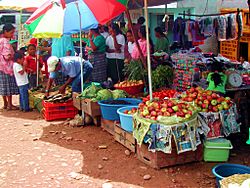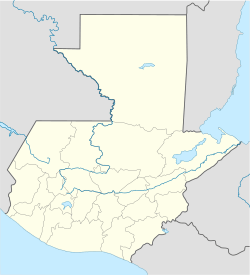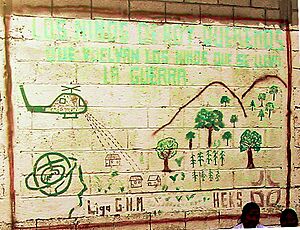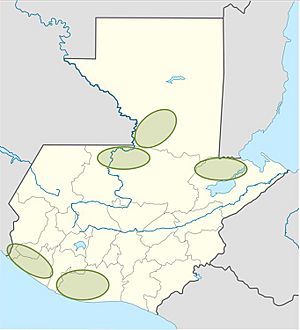Ixcán facts for kids
Quick facts for kids
Ixcán
|
|
|---|---|
|
Municipality of Guatemala
|
|

The market in Playa Grande Ixcán
|
|
| Country | |
| Department | |
| Municipal Seat | Playa Grande Ixcán |
| Area | |
| • Municipality of Guatemala | 654 sq mi (1,693 km2) |
| Population
(Census 2018)
|
|
| • Municipality of Guatemala | 99,470 |
| • Density | 152.17/sq mi (58.754/km2) |
| • Urban | 12,710 |
| • Religions | Roman Catholicism Evangelicalism |
| Climate | Af |
Ixcán is a large area in the northern part of Guatemala. It is a municipality within the El Quiché department. The main town and administrative center is called Playa Grande.
This municipality is made up of 176 smaller communities. It covers a large area of about 1,693 square kilometers. Ixcán is the northernmost part of El Quiché. It shares borders with Mexico and other parts of Guatemala. These include the departments of Alta Verapaz and Huehuetenango, and other municipalities in El Quiché.
Many different Mayan languages are spoken here. These include Q'eqchi', Q'anjob'al, Mam, Popti, and K'iche'. Spanish is also widely used.
Ixcán has its own airport. Its special code for flights is PKJ. In 2018, the population of Ixcán was 99,470 people. Every year, Ixcán celebrates its annual festival from May 15 to 17.
Contents
History of Ixcán
Early Discoveries and Development
In the 1970s, people discovered that the land in this region might have a lot of oil. Because of this, some local Q'eqchi' people were asked to move from their villages.
Around 1974, companies started taking oil out of the ground nearby. In 1976, the president of Guatemala visited Ixcán. He hinted that the area, known as the Northern Transversal Strip, was rich in natural resources like oil.
After this, oil companies explored near Ixcán. They drilled a well, but it didn't find much oil. However, these explorations led to building a dirt road through the area. This road was important for future oil projects. It also allowed powerful people to buy land in the region.
The Northern Transversal Strip
The Northern Transversal Strip was a big project. Its main goal was to help find and use oil in this large area. In 1977, General Fernando Romeo Lucas García was in charge of this project. He learned a lot about the companies working there. His family also owned land in the area.
During his time as president (1978-1982), the Army built more roads. These roads connected different parts of the Northern Transversal Strip.
The Guatemalan Civil War
Ixcán was greatly affected by the Guatemalan Civil War (1960-1996). This conflict lasted for many years. Because of the war, many people from Ixcán had to leave their homes. They sought safety in Mexico and the United States.
The Guerrilla Army of the Poor
In 1972, a new group called the Guerrilla Army of the Poor (EGP) came to Ixcán from Mexico. Many farmers welcomed them. In 1974, this group officially formed and named itself the EGP.
The EGP wanted to bring "social justice" to the area. They believed the government was not helping the people enough. To gain support, they sometimes took action against people they saw as unfair. For example, they targeted a military official and a large landowner named José Luis Arenas. People had complained that Arenas had land problems with his neighbors and treated his workers badly.
In June 1975, José Luis Arenas was killed at his farm. The EGP members told the farmers they were from the Guerrilla Army of the Poor. They said they had killed the "Tiger of Ixcán." After this event, the government at first denied that there were any guerrilla groups in the area.
Ixcán became a separate municipality in 1985. Before that, it was part of San Miguel Uspantán.
Economy
Xalalá Hydroelectric Dam
The Xalalá hydroelectric dam is a project planned for Ixcán. It would create electricity using water power. However, this project is controversial. It would flood a large area (about 31.8 square kilometers). This would force twelve Q'eqchi' Maya communities to move from their homes.
Many local groups are against the dam. They want the government to talk with the indigenous groups first. In 2007, the local government held a vote. About 90% of the voters said no to all proposed hydroelectric projects and oil drilling in the region.
African Oil Palm
There is a big demand for cooking oils in Guatemala and nearby countries. This is why the African oil palm has become very important here. Companies are investing a lot to grow palm oil. They want Guatemala to become a major exporter of palm oil.
Large palm oil farms are found in Ixcán and other areas. Companies like Palmas del Ixcán, S.A. (PALIX) have their own farms and work with other farmers.
Radio Stations
You can listen to these radio stations in Playa Grande, Ixcán:
- Stereoixcan 90.3
- Sembrador 90.7
Climate
Ixcán has a tropical rainforest climate. This means it is hot and rainy all year round.
| Climate data for Ixcán | |||||||||||||
|---|---|---|---|---|---|---|---|---|---|---|---|---|---|
| Month | Jan | Feb | Mar | Apr | May | Jun | Jul | Aug | Sep | Oct | Nov | Dec | Year |
| Mean daily maximum °C (°F) | 29.2 (84.6) |
30.6 (87.1) |
32.2 (90.0) |
33.4 (92.1) |
33.4 (92.1) |
32.4 (90.3) |
31.5 (88.7) |
31.8 (89.2) |
31.3 (88.3) |
30.6 (87.1) |
30.0 (86.0) |
29.0 (84.2) |
31.3 (88.3) |
| Daily mean °C (°F) | 23.6 (74.5) |
24.3 (75.7) |
25.9 (78.6) |
27.1 (80.8) |
27.6 (81.7) |
27.1 (80.8) |
26.5 (79.7) |
26.6 (79.9) |
26.3 (79.3) |
25.8 (78.4) |
24.9 (76.8) |
23.5 (74.3) |
25.8 (78.4) |
| Mean daily minimum °C (°F) | 18.0 (64.4) |
18.0 (64.4) |
19.7 (67.5) |
20.9 (69.6) |
21.9 (71.4) |
21.9 (71.4) |
21.6 (70.9) |
21.5 (70.7) |
21.4 (70.5) |
21.0 (69.8) |
19.8 (67.6) |
18.0 (64.4) |
20.3 (68.6) |
| Average precipitation mm (inches) | 118 (4.6) |
87 (3.4) |
76 (3.0) |
83 (3.3) |
199 (7.8) |
448 (17.6) |
449 (17.7) |
437 (17.2) |
526 (20.7) |
440 (17.3) |
224 (8.8) |
166 (6.5) |
3,253 (127.9) |
| Source: Climate-Data.org | |||||||||||||
Geographic Location
 |
Chiapas, State of México |  |
||
| Huehuetenango, Department of Guatemala | ||||
| Chajul and Uspantán, municipalities of El Quiché Department | Cobán, municipality of Alta Verapaz Department |
Images for kids
See also
 In Spanish: Ixcán para niños
In Spanish: Ixcán para niños







